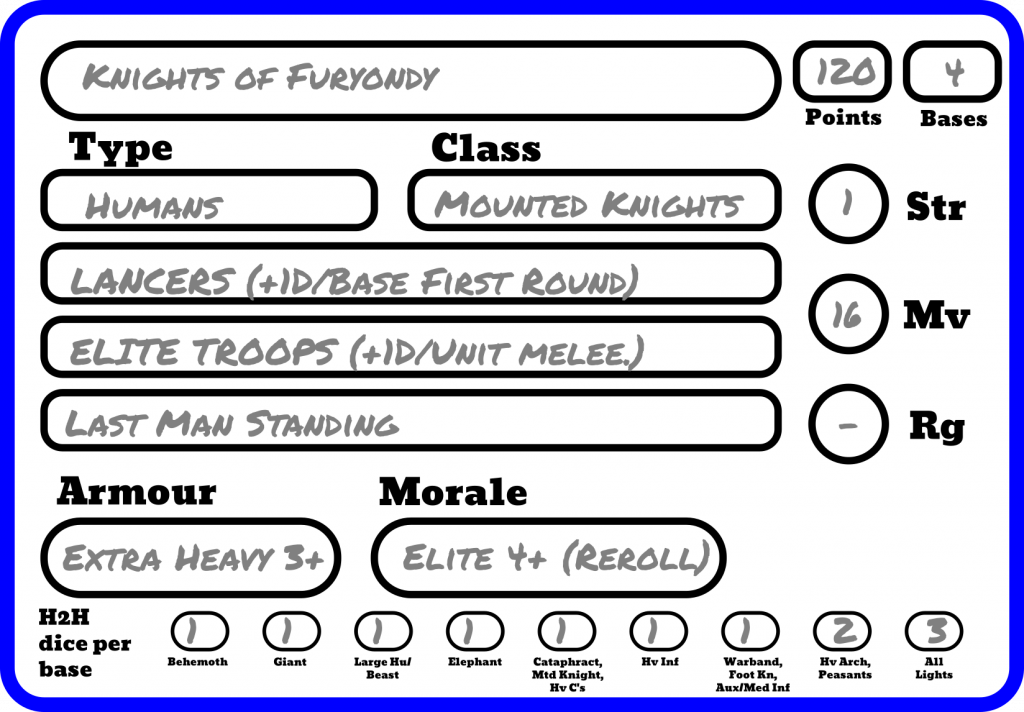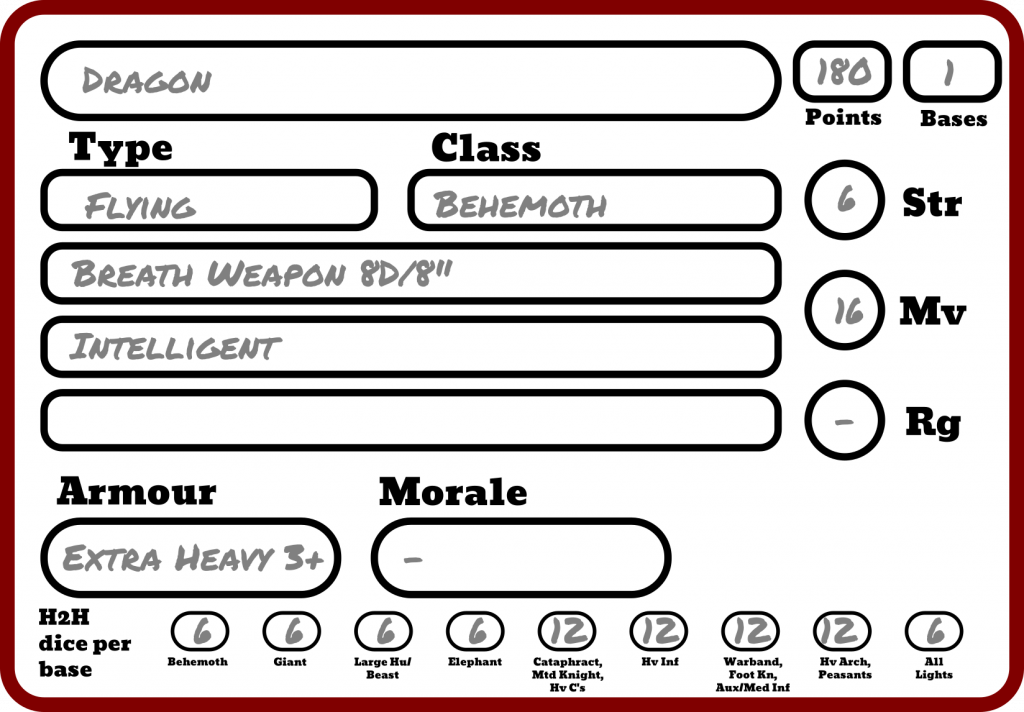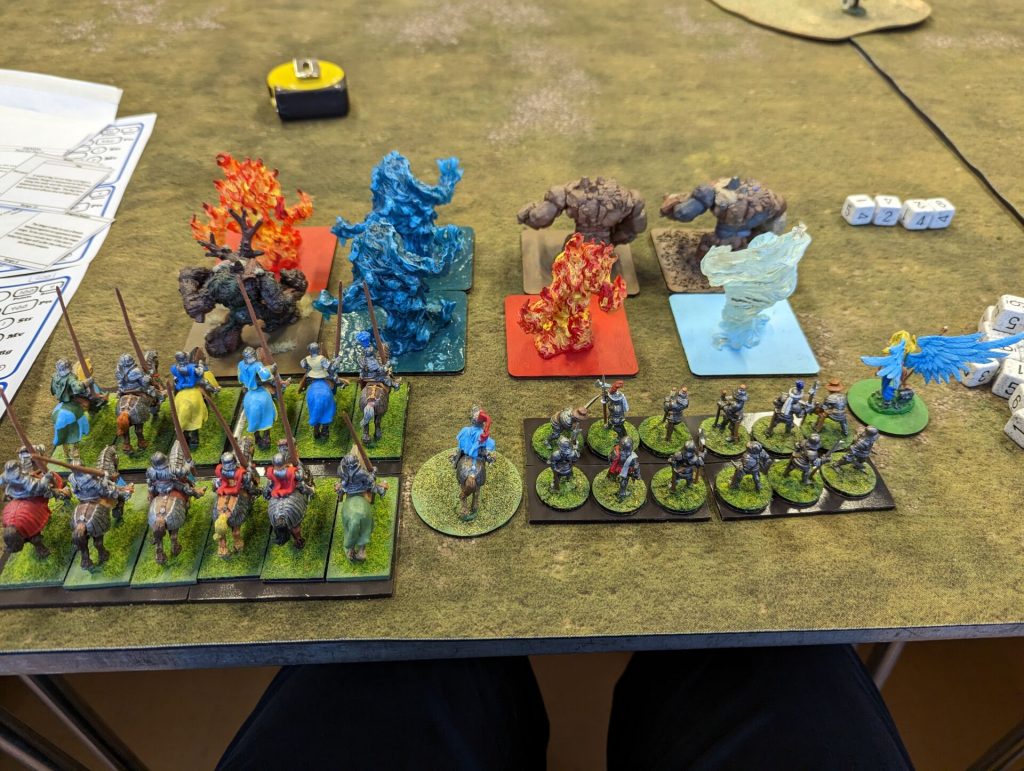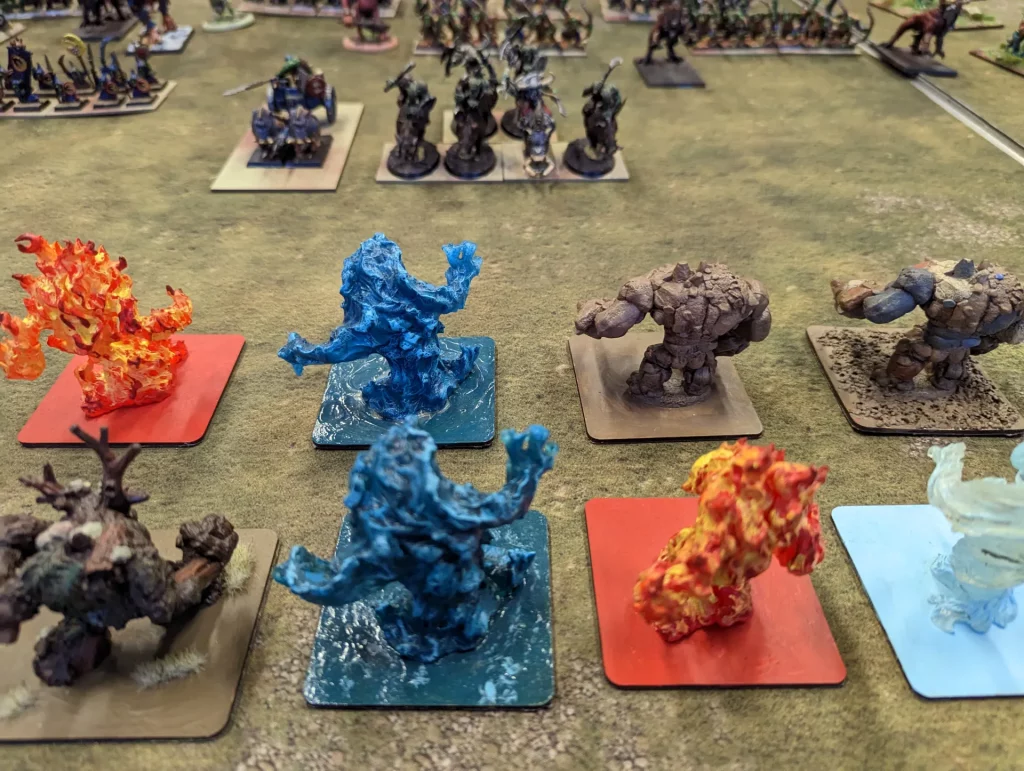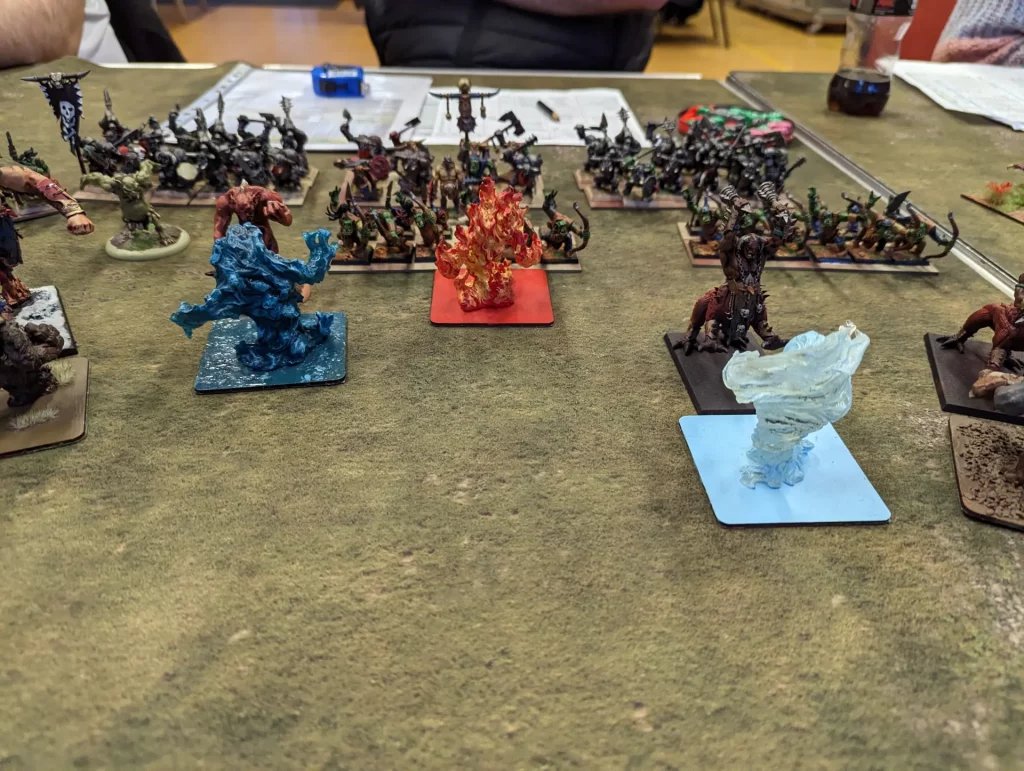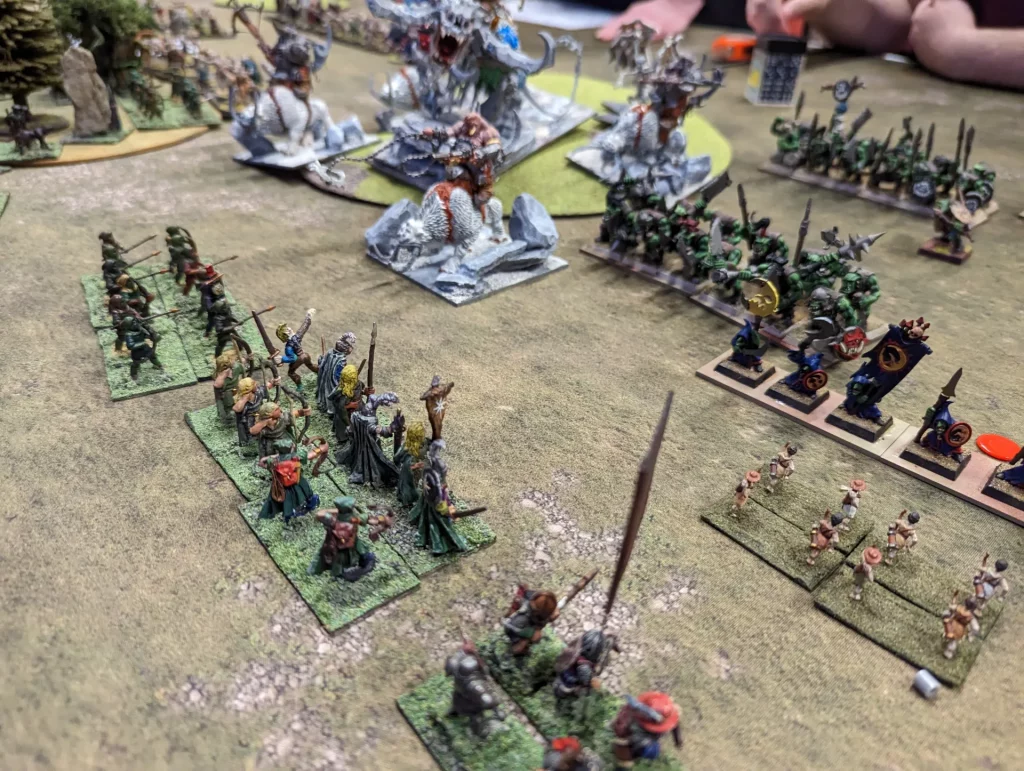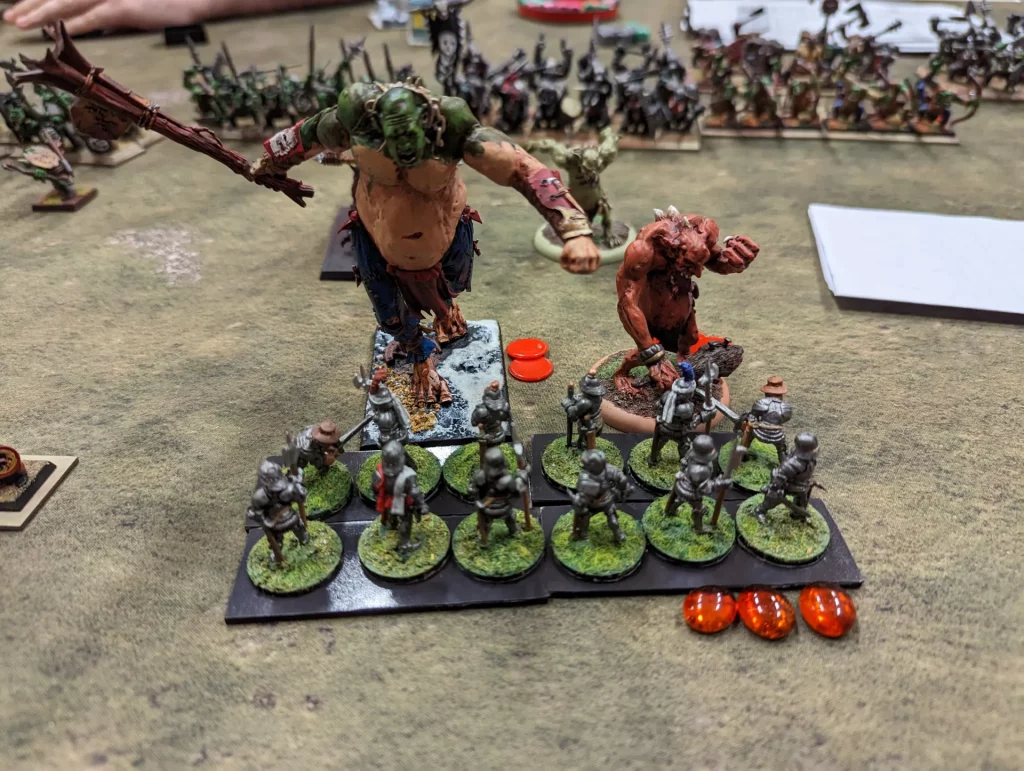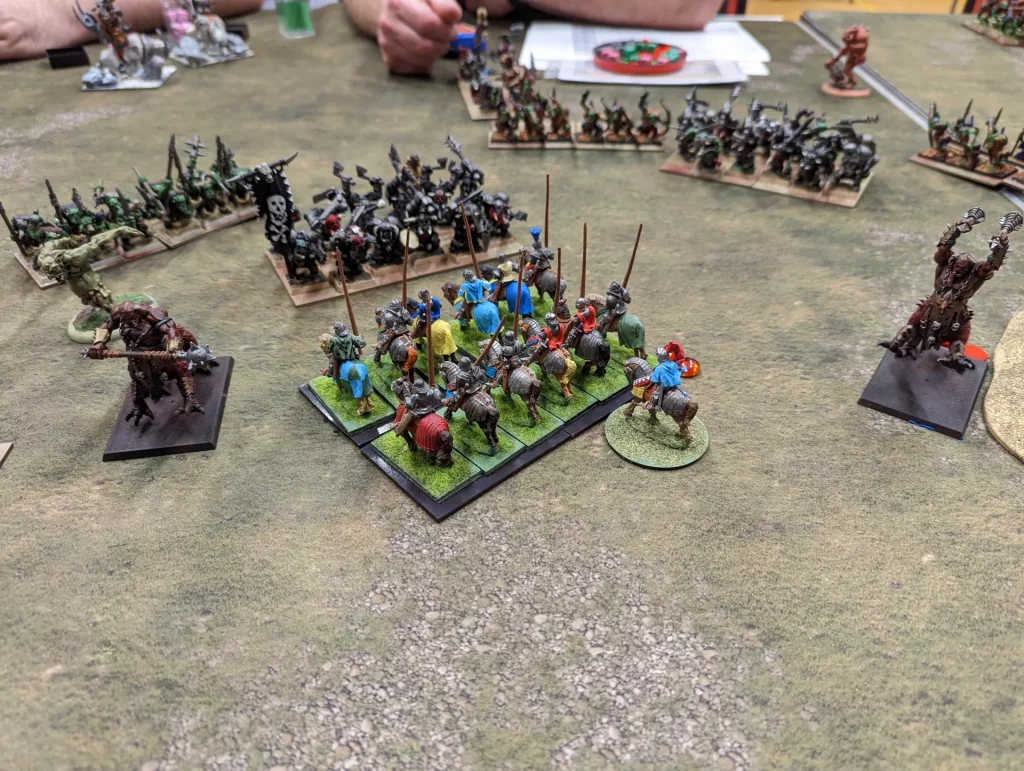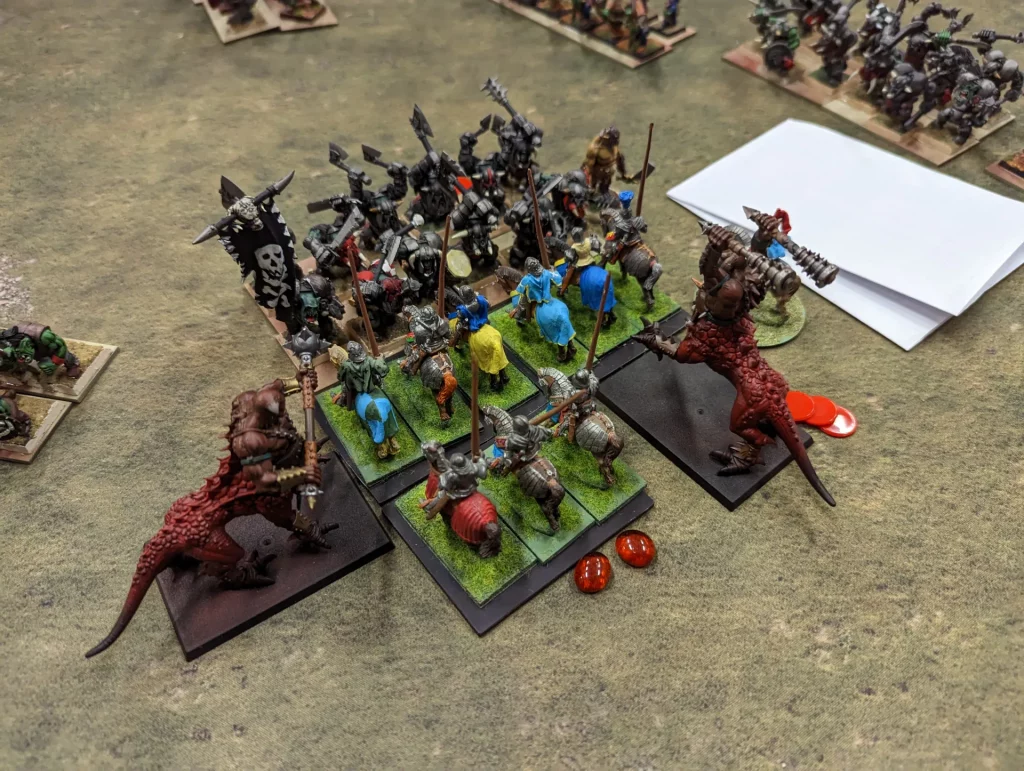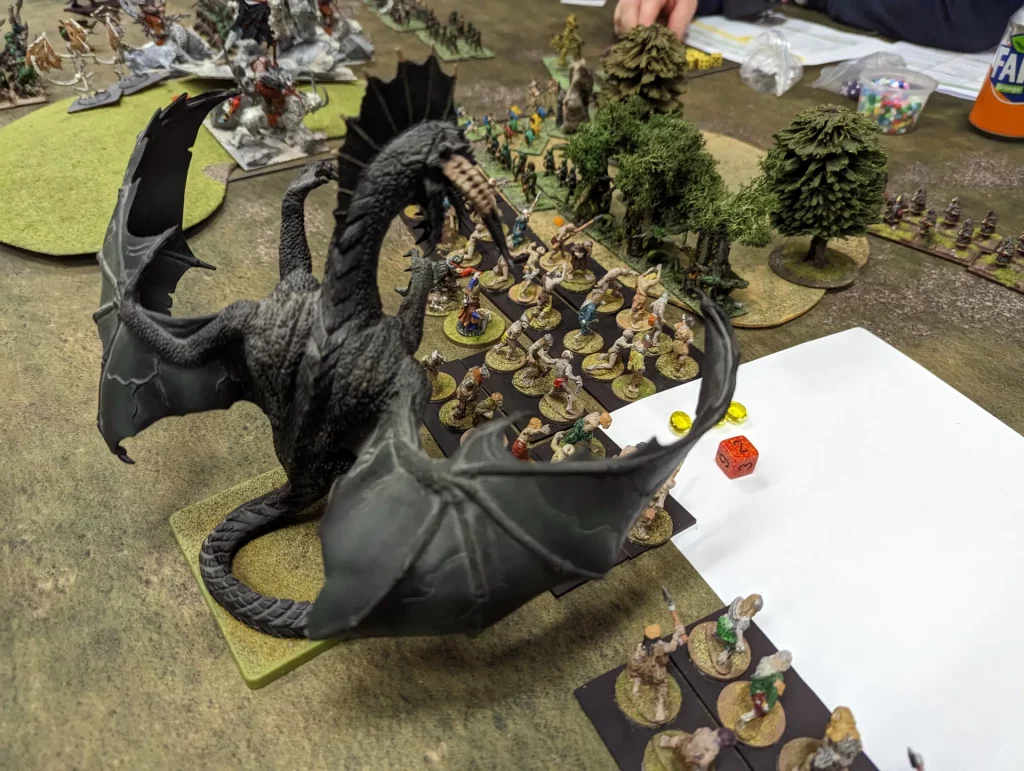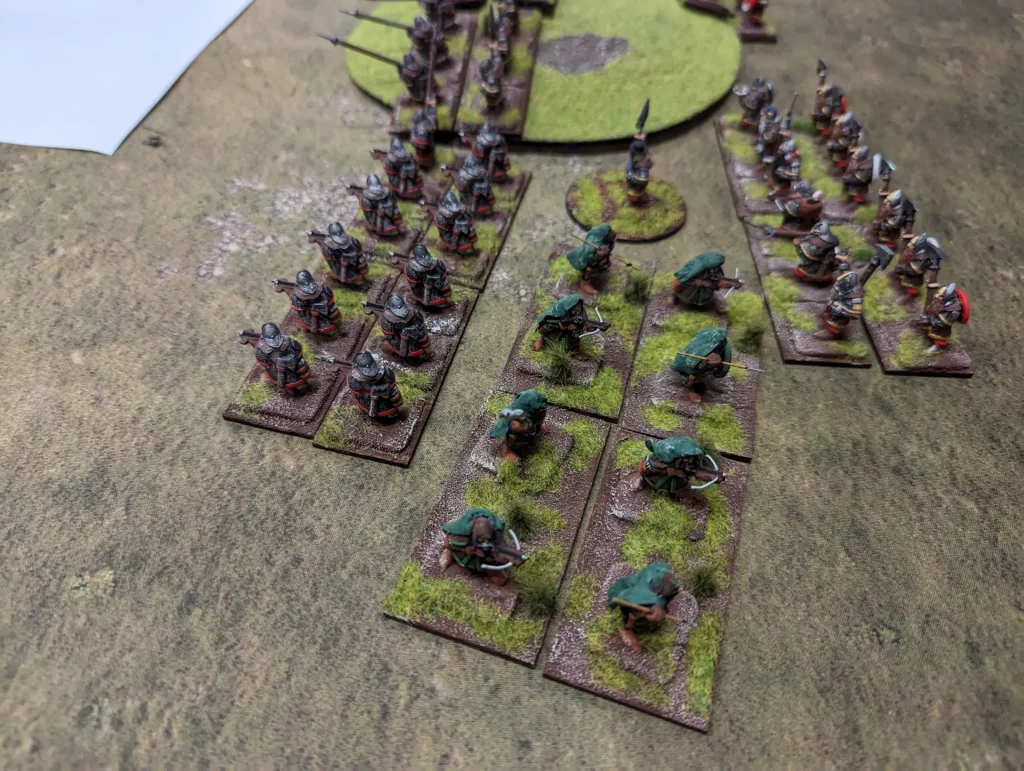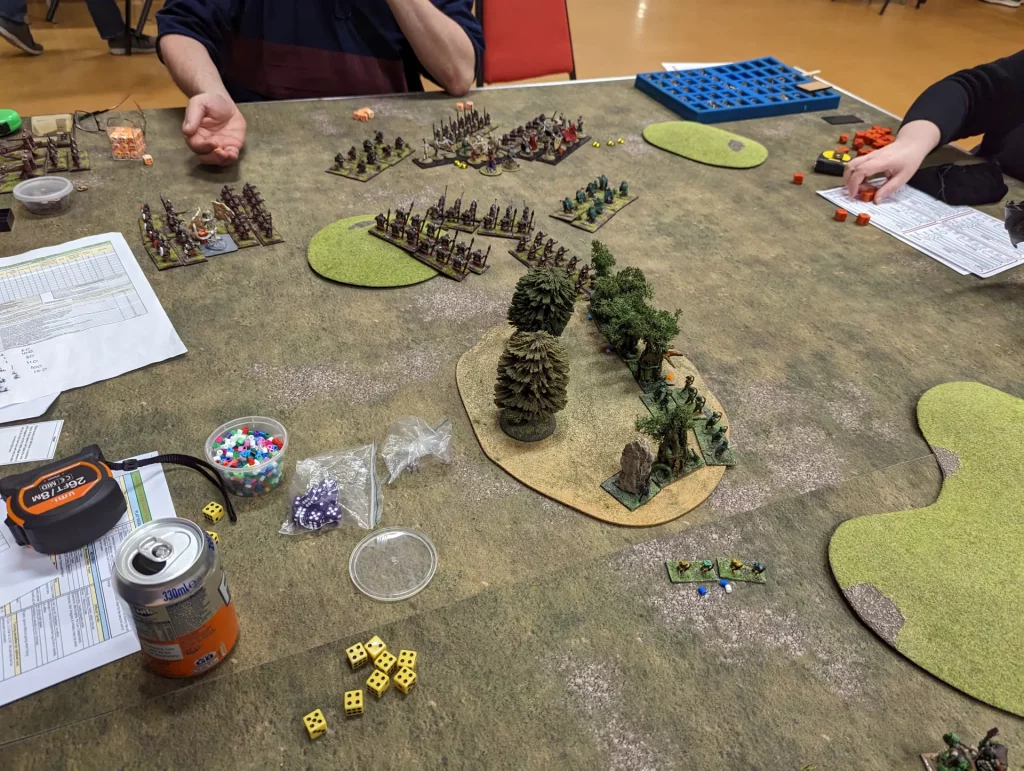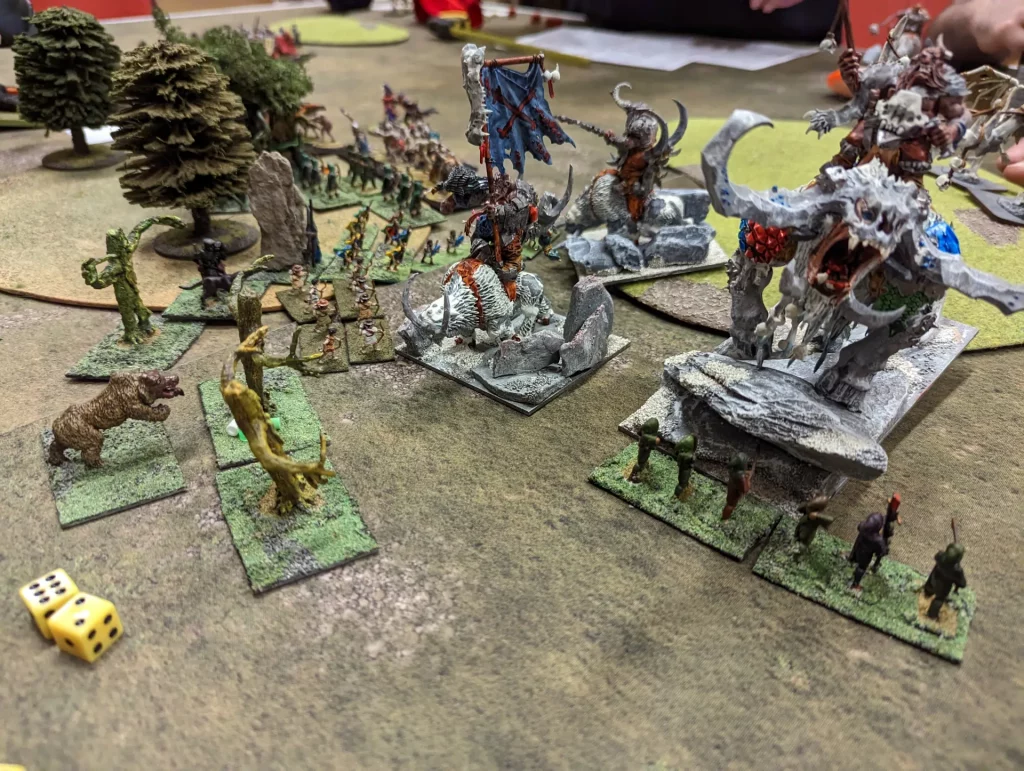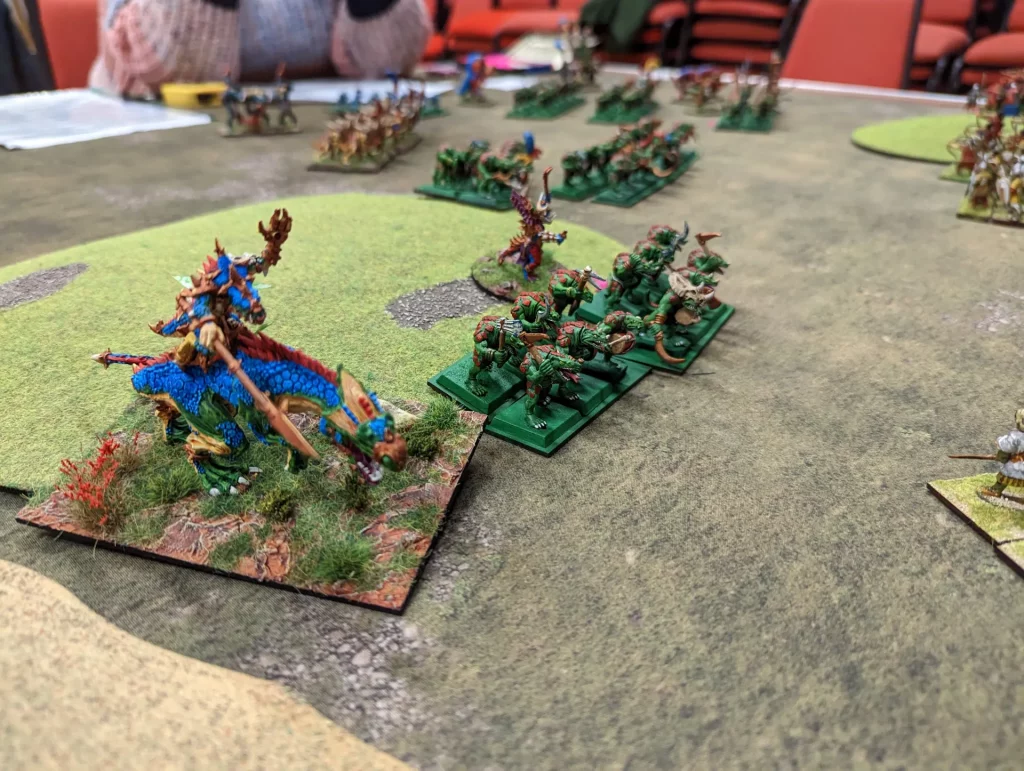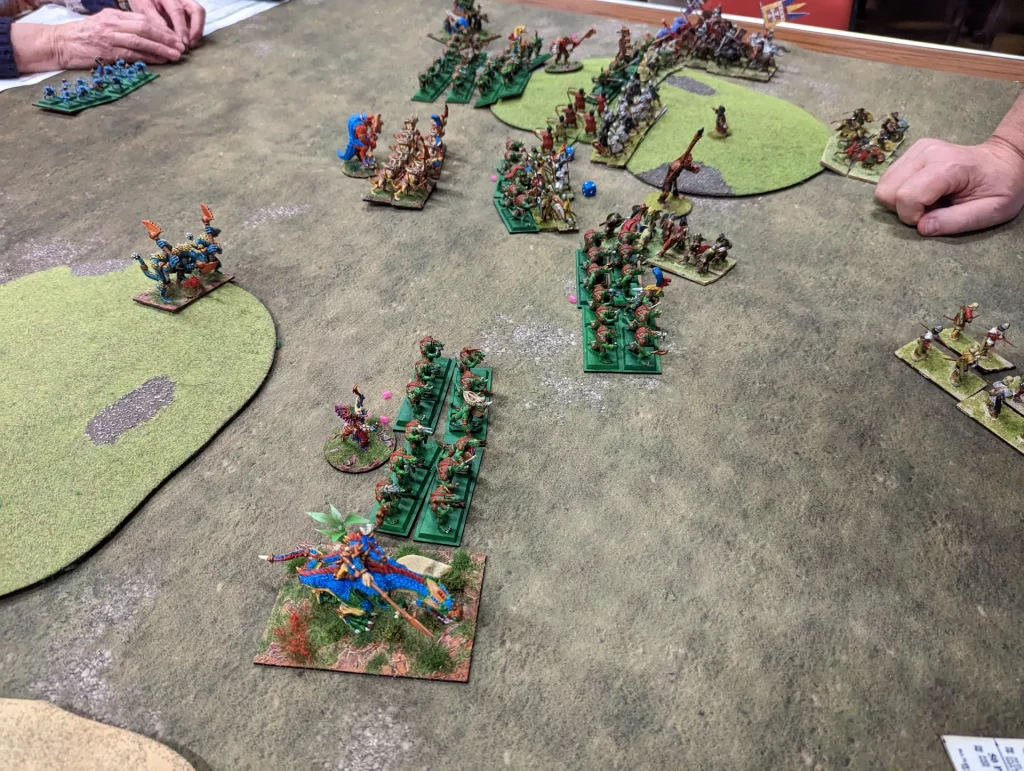Eight Fantastic Armies
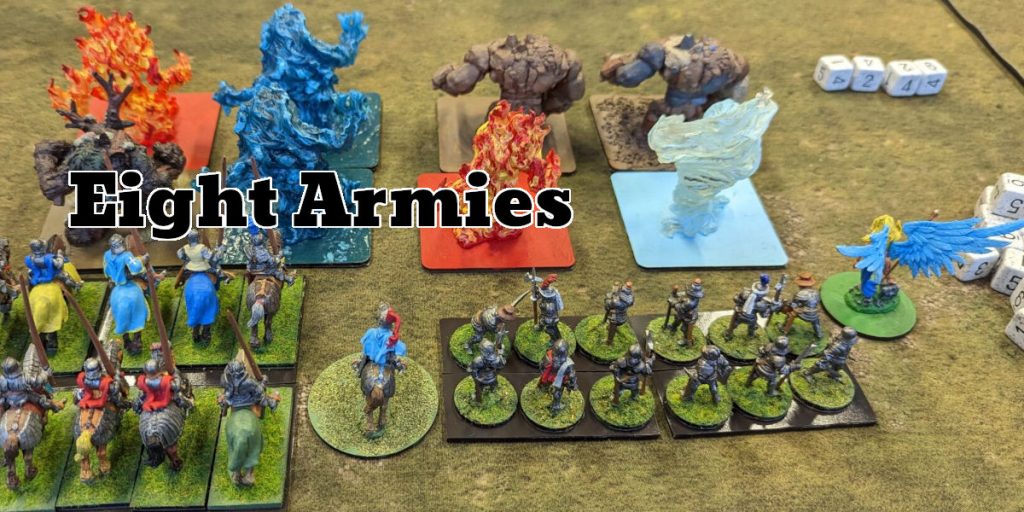
This weeks wargaming was an eight way battle between armies of light and darkness. We were using the club’s own rules, which use a generic point based system for historical and fantasy genres for a range of different figure scales. For fantasy, we tend to use 28mm, since that’s the scale used by most fantasy figures.
This was only my second game, and my first attempt at putting together an army. Actually, I put together two armies – one based on my Knights of Furyondy Saga army, the other based on my army for the Undead Hordes of Iuz. Due to a slight misreading of the rules (assuming Base Points meant the cost of each base) I ended up with two armies which were about a quarter of the expected point totals (250-300pts rather than 1,000pts). This meant a hurried redesign to re-calculate the army using the points as per unit.
There were also some abilities which were per unit, rather than per base, which required some recalculation of statistics. To try and reduce the amount of effort during the game, I did some quick statistic cards for each of my units. One example is as follows:
The bottom row is the most complicated part – there is a big table with a matrix of how many dice a type of unit rolls when attacking another unit. For most unit types, this is simply “1”.
Other units are more impressive. So the dragon on the side of Iuz has 6 or 12 attack dice, depending on what it is facing (normally 6 against other large units, or light units, but 12 against everyone else). The Dragon also has a high Strength. Strength reduces the target’s armour. Each point of strength that the attacker is higher, means armour is reduced by one level (to a minimum of 6+).
Armour is used to cancel hits. Each attack dice ‘hits’ on a D6 roll of 4+, then an armour save is allowed to ignore them. My knights have extra heavy armour, so ignore hits on a 3+. Against a dragon though, their armour is effectively a waste of points.
I was expecting to have a very small army – just a unit of mounted knights, a unit of foot knights, a hero and a flying sorceress. I’d also brought along some elementals, in case I needed more points, so these got drafted in as suicide troops. Elementals count as Expendables, so vanish after a single attack. I gave them a high (3) strength, and a bit more armour so they would be less vulnerable to archers, and filled out half my points with these one shot troops.
Other than that, my army was themed on the idea of the Kingdom of Furyondy (from the World of Greyhawk setting). Mostly humans on the side of ‘good’.

What I was directly facing were massed ranks of orcs, goblins and ogres. On my left flank was an army consisting of elves, ents and other Middle Earth forces, and on my right flank were some humans. To the far left there was also a dwarven army.
I started off with sending my elementals forward to try and disrupt the enemy ranks. The first rank took out some of the heavy goblin front units, which was definitely useful.
On the following round, the second rank of elementals did more damage, but by then the elementals were gone. Half my points spent on slowing, but not disrupting, the enemy army.
For my remaining humans, I had the options of taking the goblins head on, or veering to the left or right. I did think about going to the right, where the lizard people were charging forward. My heavy knights may have been useful there. To my left, there were some very large monsters – the same ones I had fought previously.
I really wanted to avoid these. My remaining troops were designed around the idea of having lots of heavy armour. The high strength of the larger units would make that irrelevant, so I decided to stick with the goblins. Since my knights were starting to get shot at with arrows, my sorceress put down a wall of fog to block the goblin archers.
My foot troops instead took on some trolls and ogres, which still managed to get through their armour. My foot troops took casualties and failed their morale checks, but a fireball from my sorceress helped to gain revenge by frying the large ogre.
This left only my mounted knights, who charged in to do battle. They were seriously outnumbered by this point, and it was obvious that they would get surrounded. This isn’t Saga though where you can turn in any direction, so they were more or less committed to springing the trap and killing as many as they could.
Unfortunately the heavy infantry were twice as effective against cavalry as the latter were against the infantry (2D attack per base, rather than 1D), so I didn’t last as long as I’d hoped. We did some wounds, but soon went down, fighting to the last man.
The rest of the battle had been going on whilst this was happening. My army of undead (being played by someone else) and their dragon had been surprised when some trees which were assumed to be terrain turned out to be Hourns. It stopped their advance, though the rest of the undead, plus the dragon, turned their attentions to the dwarves.
The dwarves didn’t move very far, but they had artillery which exploded when it was used against the undead. Bad luck for the dwarves I guess. The dragon was slain eventually, and an attempt to resurrect it failed.
Directly on my left, the elves and oversized beasts had been going at it. Several of the large beasts were taken out, but the elves were also having to fight the flanks of the goblin army as well, which I had been failing to stop.
On my right, the humans and lizards were making for a very colourful battle.
The last battle seemed to occur over a hill at the far end of the battle field, with the lizards seemingly taking the upper hand.
Not all armies in this battle had the same points, and there was a bit more engagement between the various armies than last time I played. That may have been partly due to being in the middle that right at the end. Large numbers of expendables didn’t really work as a tactic. It was a last minute decision, though I had been thinking of going for a slightly less extreme version of the army anyway (six, rather than eight, slightly weaker elementals).
I need to redo all my statistics cards, and come up with a proper 1,000pt army. I also need to finish painting my other two dozen mounted knights, and my crossbowmen, which are meant to join the ranks at some point.
In terms of complexity, army design is as complicated as a game like Dirtside. Lots of calculating costs for individual bases with a wide range of options. It’s a common feature of most generic games, which need to provide a lot of different options.
Saga: Age of Magic manages to avoid this to some extent, but is more complex than standard Saga which has fixed armies. I think I currently prefer the Saga method of having the complexity on the battle boards during play rather than in the army design, but they both have their advantages. I definitely need to play more Age of Magic to see how things work with more generic army types.
What I will do is build some ‘standard’ units for my FWGS designs with which I can put together some flexible armies. The statistic cards are done using Inkscape, so are basic SVG files. I’ll put them up on my website at some point (probably in time for the next battle).
